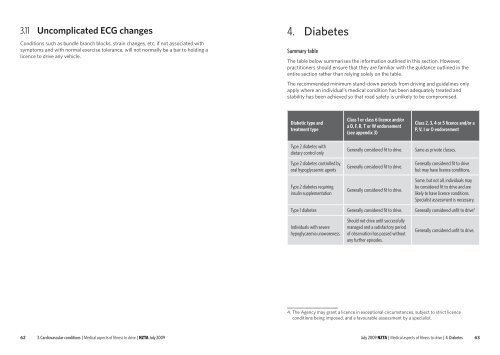Medical aspects of fitness to drive a guide for medical practitioners
Medical aspects of fitness to drive a guide for medical practitioners
Medical aspects of fitness to drive a guide for medical practitioners
You also want an ePaper? Increase the reach of your titles
YUMPU automatically turns print PDFs into web optimized ePapers that Google loves.
3.11<br />
Uncomplicated ECG changes<br />
Conditions such as bundle branch blocks, strain changes, etc, if not associated with<br />
symp<strong>to</strong>ms and with normal exercise <strong>to</strong>lerance, will not normally be a bar <strong>to</strong> holding a<br />
licence <strong>to</strong> <strong>drive</strong> any vehicle.<br />
4.<br />
Summary table<br />
Diabetes<br />
The table below summarises the in<strong>for</strong>mation outlined in this section. However,<br />
<strong>practitioners</strong> should ensure that they are familiar with the guidance outlined in the<br />
entire section rather than relying solely on the table.<br />
The recommended minimum stand‐down periods from driving and <strong>guide</strong>lines only<br />
apply where an individual’s <strong>medical</strong> condition has been adequately treated and<br />
stability has been achieved so that road safety is unlikely <strong>to</strong> be compromised.<br />
Diabetic type and<br />
treatment type<br />
Type 2 diabetes with<br />
dietary control only<br />
Type 2 diabetes controlled by<br />
oral hypoglycaemic agents<br />
Type 2 diabetes requiring<br />
insulin supplementation<br />
Class 1 or class 6 licence and/or<br />
a D, F, R, T or W endorsement<br />
(see appendix 3)<br />
Generally considered fit <strong>to</strong> <strong>drive</strong>.<br />
Generally considered fit <strong>to</strong> <strong>drive</strong>.<br />
Generally considered fit <strong>to</strong> <strong>drive</strong>.<br />
Class 2, 3, 4 or 5 licence and/or a<br />
P, V, I or O endorsement<br />
Same as private classes.<br />
Generally considered fit <strong>to</strong> <strong>drive</strong><br />
but may have licence conditions.<br />
Some, but not all, individuals may<br />
be considered fit <strong>to</strong> <strong>drive</strong> and are<br />
likely <strong>to</strong> have licence conditions.<br />
Specialist assessment is necessary.<br />
Type 1 diabetes Generally considered fit <strong>to</strong> <strong>drive</strong>. Generally considered unfit <strong>to</strong> <strong>drive</strong> 4<br />
Individuals with severe<br />
hypoglycaemia unawareness<br />
Should not <strong>drive</strong> until successfully<br />
managed and a satisfac<strong>to</strong>ry period<br />
<strong>of</strong> observation has passed without<br />
any further episodes.<br />
Generally considered unfit <strong>to</strong> <strong>drive</strong>.<br />
4<br />
4. The Agency may grant a licence in exceptional circumstances, subject <strong>to</strong> strict licence<br />
conditions being imposed, and a favourable assessment by a specialist.<br />
62 3. Cardiovascular conditions | <strong>Medical</strong> <strong>aspects</strong> <strong>of</strong> <strong>fitness</strong> <strong>to</strong> <strong>drive</strong> | NZTA July 2009<br />
July 2009 NZTA | <strong>Medical</strong> <strong>aspects</strong> <strong>of</strong> <strong>fitness</strong> <strong>to</strong> <strong>drive</strong> | 4. Diabetes 63
















